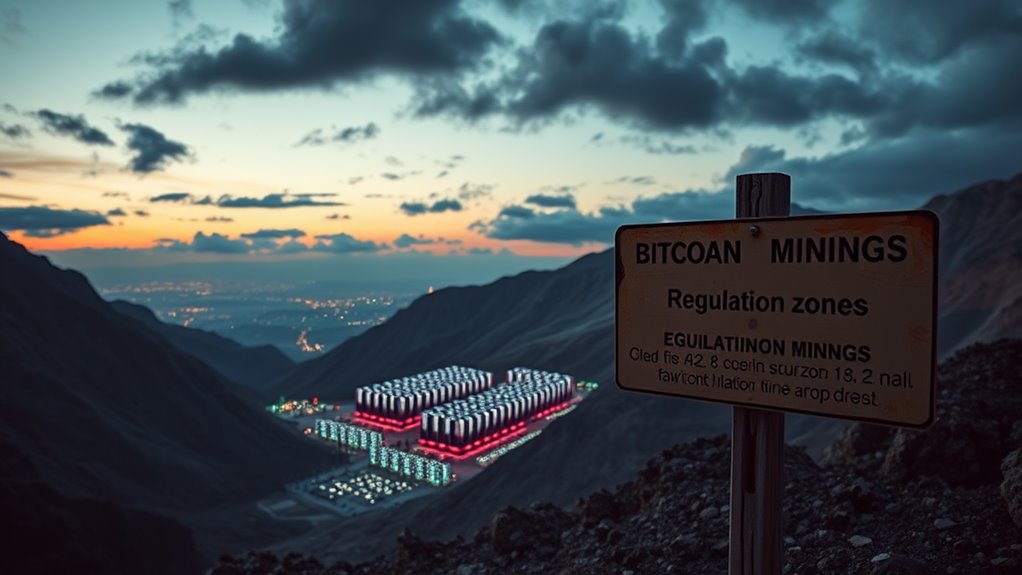
Bitcoin Mining Profitability in 2025: Is It Still Worth It?
In 2025, Bitcoin mining profitability will largely depend on several key factors. These include operational costs, fluctuating electricity prices, advancements in mining technology, and regulatory changes. The estimated cost to mine one Bitcoin remains between $26,000 and $28,000. Efficient hardware and renewable energy sources can enhance profitability. However, market volatility and strict regulations will pose challenges. Understanding these dynamics is essential for miners in evaluating future prospects. Further insights can illuminate potential opportunities ahead.
Table of Contents
Key Takeaways
- By 2025, mining one Bitcoin is estimated to cost between $26,000 and $28,000, affecting profitability based on Bitcoin’s market price.
- The anticipated hash rate of 3.7 EH/s from SEALMINER A1 highlights the shift towards more efficient mining technologies.
- Renewable energy adoption will continue to drive down operational costs, making mining more sustainable and potentially more profitable.
- Mining pools can enhance profitability by distributing costs and providing consistent income, mitigating risks associated with fluctuating Bitcoin prices.
- Regulatory environments will shape profitability; favorable regulations can support operations, while stricter controls may increase expenses for miners.
Overview of Bitcoin Mining in 2025

In what ways has Bitcoin mining evolved as it approaches 2025?
Bitcoin mining has transformed markedly due to advancements in technology and changing market dynamics. Miners now rely on specialized equipment, such as Application-Specific Integrated Circuit (ASIC) miners, to maintain competitiveness.
The global hash rate has increased dramatically, emphasizing the need for efficiency and scale. Additionally, the high energy consumption associated with mining has led to a shift towards renewable energy sources, aiming to cut costs and reduce environmental impact. The mining process has also become more sophisticated, incorporating innovative techniques for greater efficiency.
The regulatory landscape varies by country, influencing operational costs and profitability. Finally, Bitcoin’s price volatility continues to play an essential role in determining mining profitability, with higher prices generally boosting returns while lower prices diminish them.
Cost Analysis: Mining One Bitcoin

Mining one Bitcoin involves a complex interplay of various costs that have evolved considerably as the industry approaches 2025. The estimated cost of mining one Bitcoin ranges from $26,000 to $28,000, influenced by several factors:
- Electricity Costs: Miners often seek locations with low energy expenses, such as regions with hydroelectric power.
- Hardware Costs: Specialized equipment like ASICs is essential but can quickly become outdated, increasing initial investment.
- Operational Costs: Large-scale operations benefit from economies of scale, allowing for more efficient practices.
- Technological Innovations: Regular updates to mining technology are critical for maintaining competitiveness and profitability.
Additionally, as mining difficulty increases, this affects profitability by requiring more computational power and energy to mine the same amount of Bitcoin, further complicating cost evaluations. Understanding these costs is essential for evaluating the viability of Bitcoin mining as it becomes more challenging in the evolving market landscape.
The Impact of Bitcoin Prices on Profitability

Bitcoin prices greatly influence mining profitability, as fluctuations in price can directly affect the revenue generated from mined coins.
Historical trends show that past price patterns often lead to increased profitability following events such as Bitcoin halvings.
Additionally, future price predictions suggest potential growth, but the inherent volatility of Bitcoin prices means that miners must remain adaptable to changing market conditions. Moreover, the narrative of Bitcoin as a long-term store of value continues to drive investor interest, potentially stabilizing prices and benefiting miners in the long run.
Price Volatility Effects
Price volatility greatly affects miners’ revenues and operational costs. Fluctuations in Bitcoin’s price can lead to varying profit margins, making it essential for miners to adapt accordingly.
Several factors contribute to this volatility:
- Market Sentiment: Bullish or bearish attitudes can quickly change profitability.
- Economic Factors: Events like rising interest rates can negatively impact Bitcoin prices.
- Regulatory Influence: Changes in regulations may cause uncertainty, affecting investor confidence.
- Technological Developments: Innovations can stabilize or enhance Bitcoin’s market value.
Additionally, many investors trust Bitcoin as an inflation hedge, which can influence its demand and price stability during economic uncertainty.
Understanding these factors is vital for miners as they navigate the challenges posed by price fluctuations, ensuring their operations remain viable in a changing market landscape.
Historical Price Trends
The historical price trends of Bitcoin reveal a complex relationship between price fluctuations and mining profitability.
Initially introduced at zero, Bitcoin’s price increased gradually, reaching $1 in 2011 and nearly $1,000 by late 2013. The dramatic peak of $19,188 in December 2017 greatly boosted mining profitability, while the subsequent drop in 2018 forced many miners to exit.
The pandemic in 2020 led to renewed interest, with prices soaring again, but a notable decline in 2022 diminished profitability.
Throughout these changes, factors like block reward halvings, regulatory policies, and technological advancements have shaped the landscape. Additionally, the historical performance of Bitcoin often reflects market interest dynamics, which influences miner competition and profitability.
Consequently, mining profitability remains closely tied to Bitcoin’s price, reflecting the dynamics of market interest and competition.
Future Price Predictions
What factors will shape Bitcoin’s price predictions and their subsequent impact on mining profitability? Understanding these dynamics is essential for evaluating future mining ventures. Key considerations include:
- Price Fluctuations: High Bitcoin prices increase mining rewards, while low prices can strain operational costs.
- Market Sentiment: The current “Extreme Fear” sentiment can shift rapidly, affecting investor confidence and prices.
- Halving Events: The upcoming halving in April 2025 may reduce mining rewards, influencing Bitcoin’s value due to scarcity.
- Economic Influences: Global economic conditions and regulatory policies can greatly impact Bitcoin’s market value.
Additionally, diverse economic opinions on Bitcoin’s legitimacy can further shape market dynamics and investor behavior.
Electricity Costs: A Major Profitability Factor

Electricity costs are a significant factor influencing the profitability of Bitcoin mining, as they directly affect the overall expenses incurred by mining operations. High energy prices can lead to substantial financial losses, making mining less viable in regions with elevated costs.
Conversely, locations with low-cost energy, such as Norway and Iceland, are more favorable for miners. Global variations in electricity prices further impact profitability, with some countries offering cheaper rates due to abundant renewable resources.
Additionally, the adoption of renewable energy solutions not only reduces costs but also promotes environmental sustainability. As the demand for energy continues to rise, managing these expenses will be essential for miners seeking profitability in the evolving landscape of Bitcoin mining. Furthermore, the shift towards renewable energy sources may play a crucial role in shaping the future of mining operations.
The Role of Efficient Mining Hardware

Efficient mining hardware plays a vital role in determining the profitability of Bitcoin mining.
Advances in ASIC technology have led to significant cost reductions and enhanced performance, allowing miners to maximize their profit margins. Additionally, strategies that focus on utilizing the latest equipment can greatly influence operational costs, making efficient hardware essential for competitive mining operations. Furthermore, industrial mining operations are increasingly adopting advanced technologies to boost overall efficiency and profitability in the mining sector.
Impact on Profit Margins
As the landscape of Bitcoin mining evolves, the importance of efficient mining hardware becomes increasingly apparent in shaping profit margins. The choice of hardware greatly influences several aspects of mining profitability:
- Reduced energy consumption enhances overall profitability by minimizing operational costs.
- Higher hash rates, while increasing initial costs, improve the chances of solving cryptographic puzzles effectively.
- Regular upgrades to mining equipment are essential due to rapid technological advancements and obsolescence.
- Efficient cooling systems and firmware updates can further optimize performance, reducing downtime.
These factors collectively underscore the necessity for miners to invest in and maintain high-efficiency hardware, as it directly impacts their financial success in a competitive market characterized by fluctuating costs and increased competition. Furthermore, implementing Layer 2 solutions can help alleviate network congestion, thereby increasing transaction efficiency and ultimately supporting mining operations.
Advances in ASIC Technology
Advancements in ASIC technology have revolutionized the Bitcoin mining industry, greatly influencing operational efficiency and profitability.
Newer ASIC chips, particularly those utilizing 3nm technology, demonstrate significant efficiency enhancements by reducing both power consumption and heat generation. These smaller chips outperform older 4nm and 5nm versions, making them ideal for large-scale mining operations.
Companies, like Core Scientific, are also designing custom chassis that optimize airflow and performance, further enhancing mining efficiency. The modular design of these systems allows for the easy replacement of individual components, reducing maintenance costs.
As ASIC technology continues to evolve, future developments are expected to enhance scalability and adaptability, ensuring miners can respond effectively to fluctuating market conditions. Additionally, safe storage practices are essential for protecting mining profits from potential security threats.
Cost Reduction Strategies
The evolution of ASIC technology has paved the way for significant cost reduction strategies in Bitcoin mining, particularly through the adoption of more efficient mining hardware. This transformation allows miners to optimize their operations and enhance profitability.
- Decreased Hardware Costs: Mining equipment prices have dropped from $80 to $16 per terahash between 2022 and 2025.
- Energy Efficiency: Newer models prioritize energy efficiency, lowering operational costs.
- Diverse Options: Home miners can select from compact models, expanding accessibility to the market.
- Customizable Features: Equipment like the Avalon Mini 3 offers adjustable operating modes, improving versatility.
These strategies collectively enable miners to reduce expenses and increase their chances of remaining profitable in a competitive landscape.
Mining Pools and Their Influence on Earnings

Mining pools play a significant role in shaping the earnings of individual miners by providing a collaborative environment that enhances profitability. By pooling resources, miners benefit from cost efficiency, which lowers individual expenses.
Additionally, these pools offer consistent income by distributing rewards based on each member’s hash power, reducing the unpredictability of solo mining. This arrangement allows smaller miners to compete against larger operations, improving their chances of earning.
Furthermore, mining pools facilitate access to technical support and advanced hardware, further boosting potential returns. The combination of diverse cryptocurrency options and regular payouts guarantees a more stable income stream, making mining pools a valuable strategy for those seeking reliable earnings in the cryptocurrency market.
Regulatory Environment and Its Effects

The regulatory environment for Bitcoin mining in 2025 presents significant variations across different countries, impacting profitability.
Some regions, like the U.S. and Canada, have adopted favorable regulations that encourage mining, while others, such as China and parts of South America, impose stricter controls that could raise operational costs.
These diverse regulatory approaches create a complex landscape that miners must navigate to maximize their earnings and guarantee sustainable practices.
Global Regulatory Variations
As countries around the world navigate the complexities of cryptocurrency, significant variations in regulatory approaches have emerged, impacting the landscape of Bitcoin mining.
The regulatory environment varies greatly by region, influencing miners’ operations and strategies. Key points include:
- Diverse Approaches: Some nations embrace Bitcoin mining, while others impose strict regulations, such as China’s ban.
- EU Initiatives: The European Union is developing the MiCA framework to standardize regulations across its member states.
- Regional Examples: Countries like Canada promote sustainable mining, contrasting with Russia’s tightened regulations.
- Compliance Challenges: The decentralized nature of cryptocurrencies complicates regulatory enforcement and compliance measures globally.
These variations play a critical role in shaping the future of Bitcoin mining profitability and operational feasibility.
Impact on Profitability
Regulatory environments greatly influence the profitability of Bitcoin mining operations across the globe. Clear regulations can stabilize operations, while favorable tax policies may lower costs and enhance profitability.
Governments promoting renewable energy can help miners reduce both environmental impact and expenses, further improving their bottom line. Positive regulatory outcomes boost investor confidence, encouraging new investments that benefit the industry.
Compliance with regulations, however, can impose significant costs, particularly for smaller operations. Additionally, supportive policies can lead to infrastructure development and scalability options, which are vital for growth.
As regulations evolve, especially concerning environmental sustainability, miners may need to adapt by exploring alternative revenue streams, such as AI data centers or cloud mining, to maintain profitability.
Technological Advancements in Mining Equipment

With the rapid evolution of technology, advancements in mining equipment have notably enhanced the efficiency and profitability of Bitcoin mining operations.
These innovations are essential as the industry adapts to increasing challenges. Key developments include:
- ASIC Miners: Devices like the MicroBT WhatsMiner M63S achieve a hash rate of 390 Th/s while consuming 7215 watts.
- FPGA Miners: These offer up to five times the efficiency of traditional GPU miners, reducing operational costs.
- SEAL03 Chip: This technology optimizes power efficiency, reaching a remarkable 9.7 J/TH.
- Innovative Rigs: Bitdeer’s SEALMINER A1 is expected to deliver a hash rate of 3.7 EH/s, greatly boosting mining output by 2025.
These advancements play an essential role in enhancing the feasibility of Bitcoin mining in the future.
Renewable Energy Sources in Mining Operations

The evolution of Bitcoin mining technology has led to a growing interest in integrating renewable energy sources into mining operations. Many mining companies are now using hydropower and solar energy to cut costs and minimize their environmental impact.
By locating mining facilities near renewable energy sources, these operations can utilize excess energy, addressing intermittency challenges. Additionally, renewable energy enhances profitability through lower electricity prices.
In some areas, such as Kenya and Ethiopia, geothermal power is also being harnessed. This shift not only supports miners’ financial goals but also promotes local economic growth.
Future Market Dynamics and Trends in Mining

As the Bitcoin mining landscape evolves, various market dynamics and trends are set to shape its future profitability. Several key factors will influence miners’ ability to remain competitive and profitable:
- Market volatility will continue to impact Bitcoin prices, directly affecting mining revenue.
- Technological advancements necessitate frequent upgrades, increasing operational costs for smaller miners.
- Regulatory frameworks are becoming stricter, which may hinder mining operations or impose additional costs.
- Industry consolidation is expected, with larger companies dominating the market, leaving smaller miners struggling.
These factors, combined with the impending reduction in block rewards, create a complex environment for Bitcoin mining.
The upcoming reduction in block rewards adds to the complexities facing Bitcoin mining’s future profitability.
Understanding these dynamics is essential for anyone considering entering or remaining in the mining sector.
Frequently Asked Questions
What Are the Environmental Impacts of Bitcoin Mining in 2025?
In 2025, Bitcoin mining’s environmental impacts include heightened carbon emissions from fossil fuels, significant energy and water consumption, substantial land use, and increased e-waste, prompting urgent calls for renewable energy adoption and improved recycling practices.
How Do Mining Competitions Affect Profitability Among Miners?
In 2023, over 90% of Bitcoin’s hash rate was controlled by the top five mining pools. This concentration intensifies competition, driving up operational costs and forcing smaller miners to adapt technologically to remain profitable amidst rising challenges.
What Happens to Mining Profitability During Market Downturns?
During market downturns, mining profitability typically suffers due to decreased Bitcoin prices, which reduce revenue. Additionally, rising operational costs and increased competition further strain miners, making it challenging to maintain sustainable profit levels.
Are There Alternative Cryptocurrencies Worth Mining in 2025?
In the evolving landscape of cryptocurrency mining, numerous alternatives flourish. Monero, Litecoin, Zcash, Ethereum Classic, and Kaspa present diverse opportunities, appealing to miners seeking to navigate market uncertainties while optimizing their resource investments through innovative technologies.
How Can Miners Mitigate Risks Associated With Regulatory Changes?
Miners can mitigate regulatory risks by diversifying operations across jurisdictions, monitoring compliance, engaging with stakeholders, and adopting flexible technologies. Implementing sustainable practices and proactive regulatory engagement further enhances their ability to adapt to changing legal landscapes.
Conclusion
In 2025, the landscape of Bitcoin mining remains a complex tapestry woven from costs, technology, and market dynamics. While profitability hinges on factors like electricity prices and hardware efficiency, the continued evolution of mining practices and regulatory frameworks will shape its future. As miners navigate these changing currents, the decision to invest in Bitcoin mining will require careful consideration. Ultimately, the balance between risk and reward will determine whether this venture is still worth pursuing in the years ahead.



